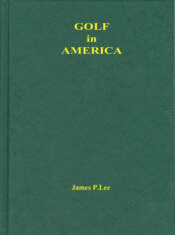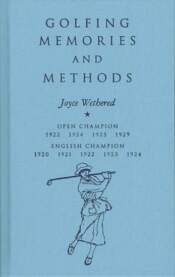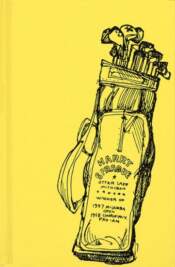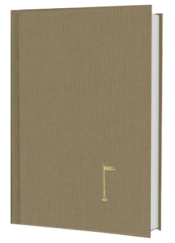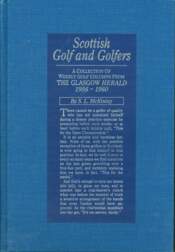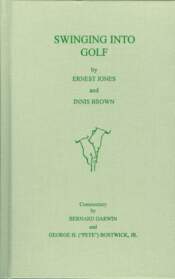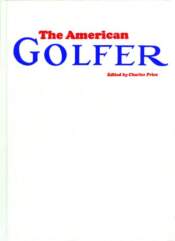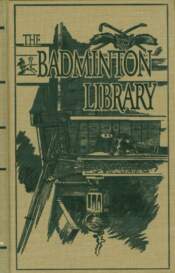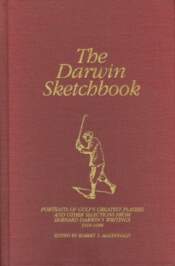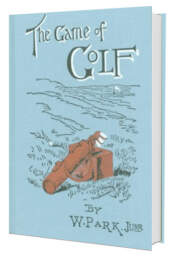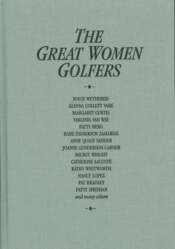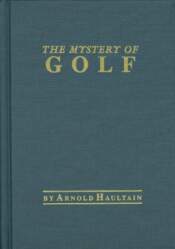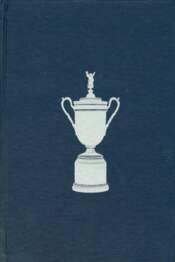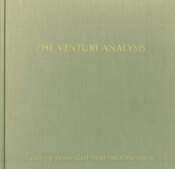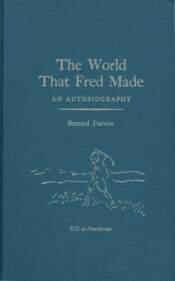-
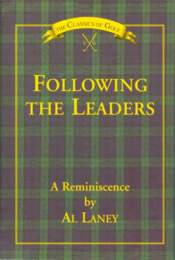 The important golf tournaments are covered of course and covered with real zest, but the centerpiece in Following the Leaders is always the personalities of the stars - how they react to pressure, how they conduct themselves when they are behind or ahead, how they prepare for championships, what their life is like off the course, how they see the world and each other. I think we probably get to know Jones, Sarazen, Collett, Wethered, Hagen, Hogan, Venturi, and Nicklaus better in these pages than other golf books. Laney knew them all. Bob Jones became one of his closest friends.
The important golf tournaments are covered of course and covered with real zest, but the centerpiece in Following the Leaders is always the personalities of the stars - how they react to pressure, how they conduct themselves when they are behind or ahead, how they prepare for championships, what their life is like off the course, how they see the world and each other. I think we probably get to know Jones, Sarazen, Collett, Wethered, Hagen, Hogan, Venturi, and Nicklaus better in these pages than other golf books. Laney knew them all. Bob Jones became one of his closest friends. -
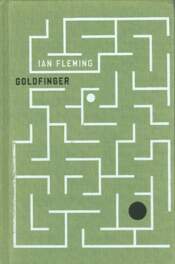 By Ian Fleming The 7th of the Bond thrillers - at its center is the description of the match between 007 and Goldfinger. One of the bestselling golf books of all time according to Valuable Golf. This book is a must for all golfers. The foreword by Robert Green describes Fleming's game and the venues used in the film.
By Ian Fleming The 7th of the Bond thrillers - at its center is the description of the match between 007 and Goldfinger. One of the bestselling golf books of all time according to Valuable Golf. This book is a must for all golfers. The foreword by Robert Green describes Fleming's game and the venues used in the film. -
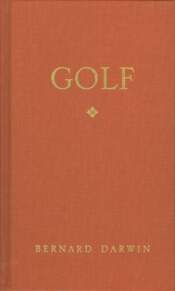
$35.00Add to cart
By Bernard Darwin The most prolific golf writer and high amateur, Darwin explains the multiple and enduring pleasures of golf in his own words and through writings culled from his favorite books on the game. You cannot possibly have a better guide. Foreword by Ian Dunlop. -
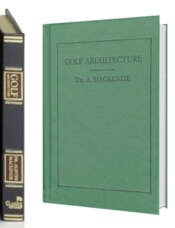
$75.00Add to cart
By Dr. Alister MacKenzie Dr. MacKenzie’s Golf Architecture was a monumental book for its time, a timeless book on golf architecture and a must for any student of the field or serious player. MacKenzie was an outdoorsman, a military man, and a doctor of medicine, whose hobby of golf architecture got the best of him. He ultimately abandoned his medical career to pursue golf course architecture and we must be thankful for that. He fully understood the nuances of the game but his genius was borne from his astute analysis of the nature of the course, its purpose and place in golf. One of the elemental distinctions he made was between strategic hazards (primarily sand bunkers, as he abhorred water as a penalty) and random hazards, as were commonly found on Scottish links—most notably at his beloved St. Andrews. The penal school of architecture was in vogue during much of MacKenzie’s life but he would have none of it. His conception of a perfect course had to do with surrounding the player, frequently challenging him, but ultimately enabling him the freedom to play, to enjoy his day at golf. MacKenzie felt too many golfers looked on hazards “as a means of punishing a bad shot, when their real object is to make the game interesting.” When his masterpiece, Augusta National Golf Club opened there were only 23 bunkers, barely more than one per hole. “Hazards should be placed with an object, and none should be made which has not some influence on the line of play...” While he is in complete agreement with John L. Low’s 1903 comment in Concerning Golf that no hazard is unfair wherever it is placed, MacKenzie avows “a hazard placed in the exact position where a player would naturally go is frequently the most interesting situation, as then a special effort is needed to get over or avoid it.” In one of the lectures that constitute this volume, MacKenzie identifies thirteen quintessential traits of the best golf architecture—the thirteen commandments for the zealous. Some are elementary: the next tee should be nearby the last green and in a direction away from following players; every hole should be of a different character and every course should have four par-threes, a couple of drive-and-pitch holes, but mostly substantial par-fours. Many qualities are more complicated: “The course should be so arranged so that the long handicap player, or even the absolute beginner, should be able to enjoy his round in spite of the fact that he is piling up a big score.” Besides ranking as one of the finest volumes on golf architecture, this book is valuable for the good course management it teaches, especially to those neophytes. Golfers must use their minds and act with authority; after all, this is war. MacKenzie was a military specialist in camouflaging earthworks; it was that peculiar skill that shaped his concepts for strategic bunkering. MacKenzie’s simple formula for a good golf course is twofold: it must never become monotonous; and the best course construction is “almost entirely due to utilization of natural features to the fullest extent and to the construction of artificial ones indistinguishable from nature.” He was also one of the earliest proponents of hazards to putting, designing unique greens such as the seventeenth at Augusta where the vertical halves slope in opposite directions, or the fifth with its backward tiering. He wanted the route to the green to be generous, never lined with ball-gobbling rough or ponds, but he could also be audacious when given property with substantially different terrain, as on the Monterey Peninsula for Cypress Point. Wisely there, the green movement is more tempered due to the high risk factor of many other shots, and perhaps the distracting drama of the surrounds. Admirers of the art of Mackenzie in the U. S. should also view Ohio State University GC, the University of Michigan GC and Crystal Downs CC, Green Hills CC (CA ), Pasatiempo GC, Northwood GC and Stockton G & CC. While totally serious and eminently important, this book is far from a chore to read. Although a stern, physically imposing Scot, MacKenzie liked a joke, even if at possibly his own expense. One of two rival green shapers admitted he could never quite achieve the subtle contours of the other, and asked his secret. “The other replied that it was perfectly easy; he simply employed the biggest fool in the village and told him to make them flat.” Foreword by Herbert Warren Wind, Afterword by Lewis A Lapham. -
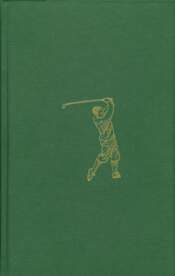
$40.00Add to cart
By Bobby Jones This is Bobby Jones' second and final autobiography. From 1923 to 1930, Jones won 13 national championships, and from 1922-1930 he was first or second in the U.S. Open, save one year. The impossible was accomplished by Bobby Jones in the magical year of 1930 when he won the British Amateur and Open Championships and the U. S. Amateur and Open Championships. Shortly thereafter, Bobby Jones announced he would play no more tournament golf, enigmatically stepping from the loftiest of competitive heights into the annals of golf history. Foreword by Bernard Darwin. -
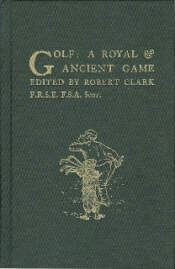 Edited by Robert Clark This is one of the earliest books on golf (1875) and the first history of the game. Robert Clark, an Edinburgh printer, did a phenomenal job gathering together all the best literature and documents that had been published or printed up to that time, all describing an exclusive and provincial Scottish game that no one in their right mind could imagine would someday spread around the world. If you have any interest in the history of the game, you have to get to know Clark’s book. Among other treasures, it contains “The Goff”, the famous poem which, when published in 1744, became the first book devoted entirely to golf. Foreword by William Gifford.
Edited by Robert Clark This is one of the earliest books on golf (1875) and the first history of the game. Robert Clark, an Edinburgh printer, did a phenomenal job gathering together all the best literature and documents that had been published or printed up to that time, all describing an exclusive and provincial Scottish game that no one in their right mind could imagine would someday spread around the world. If you have any interest in the history of the game, you have to get to know Clark’s book. Among other treasures, it contains “The Goff”, the famous poem which, when published in 1744, became the first book devoted entirely to golf. Foreword by William Gifford. -
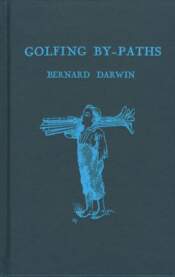
$40.00Add to cart
By Bernard Darwin Golfing By-Paths, long out of print and little known in the U.S., is a collection of 58 essays written by the great British golf writer between 1939 and 1945. “In these essays you can see Darwin endeavoring to keep the flame of golf alive amidst the privations of war,” says Classics of Golf Publisher Michael P. Beckerich. “He falls back on his memories of golf as a pillar English social life, the club as a haven, and allows himself some hope that these pleasures will not be totally lost.” This book showcases the amazing talent of Darwin's gift of writing. Foreword by Michael P. Beckerich. -
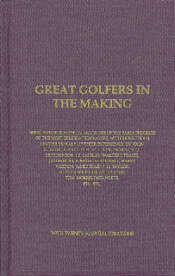 Edited by Henry Leach Autobiographical accounts of the early progress of the most celebrated players, with reflections on the morals of their experience by John L. Low, Harold H. Hilton, Horace G. Hutchinson, J.E.Laidlay, Walter J. Travis, James Robb, Edward Blackwell, Harry Vardon, James Braid, J.H. Taylor, Alexander Herd, Willie Park, Tm Morris, Jack White and others. Fascinating first person accounts of the greatest players. Foreword by Robert S. Macdonald.
Edited by Henry Leach Autobiographical accounts of the early progress of the most celebrated players, with reflections on the morals of their experience by John L. Low, Harold H. Hilton, Horace G. Hutchinson, J.E.Laidlay, Walter J. Travis, James Robb, Edward Blackwell, Harry Vardon, James Braid, J.H. Taylor, Alexander Herd, Willie Park, Tm Morris, Jack White and others. Fascinating first person accounts of the greatest players. Foreword by Robert S. Macdonald. -
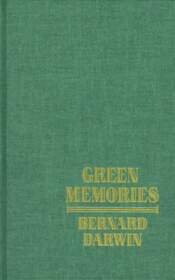
$40.00Add to cart
By Bernard Darwin The first of three autobiographies by the greatest golf writer of all time. This book is widely considered one of Darwin's best efforts which means it is one of the best golf books ever written. Indispensable for any golf library. Forewords by Bill Scheft and John Hopkins, golf correspondent for the London Times. -
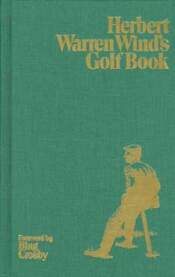 By Herbert Warren Wind A stirring collection of magazine articles and excerpts assembled only the way Herbert Warren Wind can. Wind offers his thoughts on Hogan, Snead, Venturi and Darwin, among others. They inspired thousands of golfers and set the standards for the golf writers that followed. This collection contains some of his most famous pieces on the great players, tournaments, golf architecture, turning points in the history of the game, and unusual aspects of golf that no one else bothered to write about . The story of one of the Triumvirate who, at the turn of the century, along with Taylor and Vardon, elevated the game from a Scottish curiousity to a level of unimaginable popularity, North to the Links of Dornach”, “The 1964 United States Open: The Third Man”, and “Some Thoughts on Golf Course Architecture”. The best from America’s best golf writer. Foreword by Bing Crosby.
By Herbert Warren Wind A stirring collection of magazine articles and excerpts assembled only the way Herbert Warren Wind can. Wind offers his thoughts on Hogan, Snead, Venturi and Darwin, among others. They inspired thousands of golfers and set the standards for the golf writers that followed. This collection contains some of his most famous pieces on the great players, tournaments, golf architecture, turning points in the history of the game, and unusual aspects of golf that no one else bothered to write about . The story of one of the Triumvirate who, at the turn of the century, along with Taylor and Vardon, elevated the game from a Scottish curiousity to a level of unimaginable popularity, North to the Links of Dornach”, “The 1964 United States Open: The Third Man”, and “Some Thoughts on Golf Course Architecture”. The best from America’s best golf writer. Foreword by Bing Crosby. -
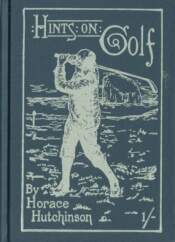 By Horace Hutchinson Foreword by Herb Wind, Afterword by Jack Nicklaus This is a seminal book in the library of golf, being the first mass-produced book of instruction. In spite of its diminutive size, Hints on the Game of Golf was such a revelation to the uninitiated and aspiring players that it was an immediate success. Nor was the success short-lived, as the book was in print for 20 years through 14 printings. This is the author’s first work and a watershed volume in golf literature. The attraction of this century old book is not the technical instruction; the long nose clubs of that era required a much different swing than we need with today’s modern equipment. Its fascination is that Hutchinson saw the need for such a book and that the result is engaging still today. This is not a dry, club-by-club instructional like so many modern offerings. Spirited and informal, it is part description, part admonishment, part scientific treatise, and part recitation of the truisms from the ancient game. Hutchinson actually cites himself as having often said golf could not be taught successfully through a book, but he explains his reversal in the introduction. Hutchinson wrote this book partly out of frustration at seeing men playing golf “in a style in which it is physically, anatomically, mathematically, from very conceivable point of view, impossible for a human being, made on any known plan, to strike the ball correctly.” This is another 'must have' book.
By Horace Hutchinson Foreword by Herb Wind, Afterword by Jack Nicklaus This is a seminal book in the library of golf, being the first mass-produced book of instruction. In spite of its diminutive size, Hints on the Game of Golf was such a revelation to the uninitiated and aspiring players that it was an immediate success. Nor was the success short-lived, as the book was in print for 20 years through 14 printings. This is the author’s first work and a watershed volume in golf literature. The attraction of this century old book is not the technical instruction; the long nose clubs of that era required a much different swing than we need with today’s modern equipment. Its fascination is that Hutchinson saw the need for such a book and that the result is engaging still today. This is not a dry, club-by-club instructional like so many modern offerings. Spirited and informal, it is part description, part admonishment, part scientific treatise, and part recitation of the truisms from the ancient game. Hutchinson actually cites himself as having often said golf could not be taught successfully through a book, but he explains his reversal in the introduction. Hutchinson wrote this book partly out of frustration at seeing men playing golf “in a style in which it is physically, anatomically, mathematically, from very conceivable point of view, impossible for a human being, made on any known plan, to strike the ball correctly.” This is another 'must have' book. -
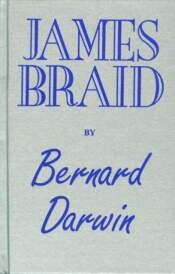
$35.00Add to cart
By Bernard Darwin The story of one of the Triumvirate who, at the turn of the century, along with Taylor and Vardon, elevated the game from a Scottish curiosity to a level of unimaginable popularity. Foreword by Bernard Darwin. -
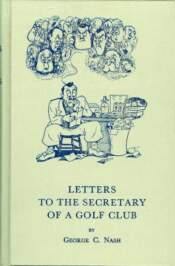 By George Nash An underground classic for decades, this is a truly hilarious account of the breaking of the mental health of the secretary of a British golf club because of the incessant threats and sabotages by club members such as the ferocious General Sir Armstrong Forcursue. Upon his appointment, the Job-like Secretary, Patrick Whelk, receives this note: “Dear Sir, I hear that you are the new Secretary. May Heaven Help You.” Foreword by Robert S. Macdonald.
By George Nash An underground classic for decades, this is a truly hilarious account of the breaking of the mental health of the secretary of a British golf club because of the incessant threats and sabotages by club members such as the ferocious General Sir Armstrong Forcursue. Upon his appointment, the Job-like Secretary, Patrick Whelk, receives this note: “Dear Sir, I hear that you are the new Secretary. May Heaven Help You.” Foreword by Robert S. Macdonald. -
 Edited by Peter Ryde--a brilliant collection of Darwin One of the inescapable charms of Darwin’s writings is his ability to see with the eyes of a child while thinking with the mind of a highly educated adult. An Attack of Socketing is Darwin at his impish best. At worst, it is a story going nowhere; at best, it is a story that ends up where it began. Read how an attack of the “shanks” or “socketing” (when the ball goes dead right at impact for a right-handed player) can and does infect the average and best players. Hogan at Carnoustie, the immortal James Braid, Ouimet at Brookline, Bobby Jones in quest of the Grand Slam and after his announced retirement: all are the subjects of wonderful pieces. However, the more obscure Darwin becomes in search of a topic, the better the results. Take When Slices were Slices, which contains no advice, although it is loosely about the six different types of slices Seymour Dunn describes in Standardised Golf Instruction. Sensitive of his reader’s game, Darwin avoids detailing the six slices “because to read a medical book is to invariably to believe that one has got every disease under the sun.”
Edited by Peter Ryde--a brilliant collection of Darwin One of the inescapable charms of Darwin’s writings is his ability to see with the eyes of a child while thinking with the mind of a highly educated adult. An Attack of Socketing is Darwin at his impish best. At worst, it is a story going nowhere; at best, it is a story that ends up where it began. Read how an attack of the “shanks” or “socketing” (when the ball goes dead right at impact for a right-handed player) can and does infect the average and best players. Hogan at Carnoustie, the immortal James Braid, Ouimet at Brookline, Bobby Jones in quest of the Grand Slam and after his announced retirement: all are the subjects of wonderful pieces. However, the more obscure Darwin becomes in search of a topic, the better the results. Take When Slices were Slices, which contains no advice, although it is loosely about the six different types of slices Seymour Dunn describes in Standardised Golf Instruction. Sensitive of his reader’s game, Darwin avoids detailing the six slices “because to read a medical book is to invariably to believe that one has got every disease under the sun.” -
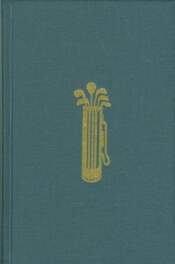 By Percy Boomer "This is not a book," wrote Percy Boomer, "on the science of golf, but about learning it. Everything in the science of the game has been written, little on how to learn it. So I outline a method of learning and stress certain points about the golf swing." Boomer teaches you how the correct golf swing feels in all its component parts. Once you know how it feels you can train your body to duplicate that feel and you can accept or reject advice from anyone on the basis of its feel. The idea is to find the way to take the cerebral cortex, so to speak, out of the swing and to make it a part of our instinctual life.
By Percy Boomer "This is not a book," wrote Percy Boomer, "on the science of golf, but about learning it. Everything in the science of the game has been written, little on how to learn it. So I outline a method of learning and stress certain points about the golf swing." Boomer teaches you how the correct golf swing feels in all its component parts. Once you know how it feels you can train your body to duplicate that feel and you can accept or reject advice from anyone on the basis of its feel. The idea is to find the way to take the cerebral cortex, so to speak, out of the swing and to make it a part of our instinctual life. -
 By Bernard Darwin A must have edition for the Darwin fan! It is hard to believe how well Darwin writes until you open this volume at any short chapter and get whisked off on Darwin’s magic carpet to wherever he wants to take you. No wonder his writing has lost none of its immediacy. He makes you understand and appreciate the game on a deep emotional level. It’s what has made him the greatest golf writer ever and, some think, the greatest writer on sport. Reading Darwin is one of the most pleasurable aspects of an involvement in golf. It makes you feel almost as good as hitting a long, straight drive. Here's an excerpt from the review on Cybergolf.com: "Out of the Rough is a superb collection of Bernard Darwin's columns from the early 1930s. The columns include some of Darwin's all-time classics, including “Old Pawky,” where he talks about Willie Park's wooden putter; “Hail and Farewell,” in which Darwin discusses Bobby Jones' retirement, and “The Best Ever,” where Darwin describes the best golfer in history. Darwin's observations on golf are unfailing, which help make him a great read today, some 70 years after these columns were written. This book is a faithful reproduction of the original, beautifully captured in a traditional Smyth-sewn, hardcover binding. Early editions of the book sell for $700 and more. Foreword by Henry Longhurst.
By Bernard Darwin A must have edition for the Darwin fan! It is hard to believe how well Darwin writes until you open this volume at any short chapter and get whisked off on Darwin’s magic carpet to wherever he wants to take you. No wonder his writing has lost none of its immediacy. He makes you understand and appreciate the game on a deep emotional level. It’s what has made him the greatest golf writer ever and, some think, the greatest writer on sport. Reading Darwin is one of the most pleasurable aspects of an involvement in golf. It makes you feel almost as good as hitting a long, straight drive. Here's an excerpt from the review on Cybergolf.com: "Out of the Rough is a superb collection of Bernard Darwin's columns from the early 1930s. The columns include some of Darwin's all-time classics, including “Old Pawky,” where he talks about Willie Park's wooden putter; “Hail and Farewell,” in which Darwin discusses Bobby Jones' retirement, and “The Best Ever,” where Darwin describes the best golfer in history. Darwin's observations on golf are unfailing, which help make him a great read today, some 70 years after these columns were written. This book is a faithful reproduction of the original, beautifully captured in a traditional Smyth-sewn, hardcover binding. Early editions of the book sell for $700 and more. Foreword by Henry Longhurst. -
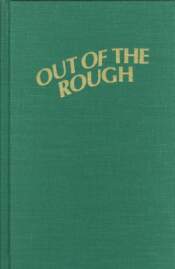 By Joseph T. Shaw An absolutely irresistible story about a young American who travels to Elie, in the kingdom of Fife, to learn the game from a master and win the girl he loves. Needless to say, his dreams change rather radically in Scotland. All the characters are brought beautifully and authentically to life. A lovely read.
By Joseph T. Shaw An absolutely irresistible story about a young American who travels to Elie, in the kingdom of Fife, to learn the game from a master and win the girl he loves. Needless to say, his dreams change rather radically in Scotland. All the characters are brought beautifully and authentically to life. A lovely read. -
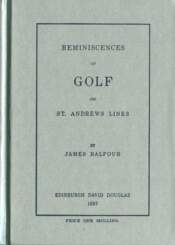 By James Balfour One of the rarest and most sought-after golf books ever produced. It is one of the earliest first-hand accounts of golf at St. Andrews. It begins in the feather ball era and concludes in the 1880s. This is a high grade reproduction of this delicate 127 year old book that is listed in Gilchrist's Guide to Golf Collectibles at $7,000. Foreword by Herbert Warren Wind, Afterword by Jack Nicklaus
By James Balfour One of the rarest and most sought-after golf books ever produced. It is one of the earliest first-hand accounts of golf at St. Andrews. It begins in the feather ball era and concludes in the 1880s. This is a high grade reproduction of this delicate 127 year old book that is listed in Gilchrist's Guide to Golf Collectibles at $7,000. Foreword by Herbert Warren Wind, Afterword by Jack Nicklaus -
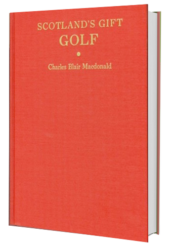
$65.00Add to cart
By Charles B. Macdonald One of the masterpieces of golf literature by America's first official golf champion and one of its foremost golf architects. Afterword by Alister Cooke. -

$50.00Add to cart
By H.N. Wethered and T. Simpson The Architectural Side of Golf, written at the close of the golden era of golf architecture, is the discipline’s grandest literary gem. It is the last and most lavish of the several books on design published during the 1920s, with 44 plates drawn by Simpson and 26 etchings by Wethered. The authors reaped the benefit of seeing prior publications and crafted this to be as little like a textbook as possible, while exploring a wide variety of subjects directly and indirectly related to architecture. Excepting Sutton’s 1933Golf Courses: Design, Construction and Upkeep, this would be the last book published on golf course architecture for decades. Familiar to designers, The Architectural Side of Golf should also be in the hands of amateurs and committee persons who tinker with re-design or contemplate alteration of their home courses. The authors surmise the golf course is at a crossroads. In the 1920s, they say, gone are the carefree days of yore when the players were “a mere handful of local enthusiasts who did not, perhaps, take the game in quite as serious a spirit as is the present custom.” The modern ball and clubs produce better, longer shots of controlled shapes in the hands of the pros. Match play has given way to stroke play and thus increased attention to every strike. This is modern golf, attacking all the time, shooting for the pin. The best players now practice regularly—even putting—and thereby invent all manners of shots to escape trouble. The authors ponder how an architect can defend the onslaught against par. In the beginning of the 21st century, we frequently hear critics argue, “today’s golf ball goes too far.” Distance was as hot a topic in the Roaring Twenties as it is now. How accurate Simpson and Wethered were in their prediction about balls: “In all probability there is still room for an additional length quite sufficient to upset present calculations.” Another concern for architects of that era—and this—is the degree to which wedge play had been perfected. The design solutions for today are as then. In the search to frustrate the constantly dropping scores, success is not to be found in lengthening the holes—the ball will keep going further. Rather, allow semi-rough come into play more, make primary rough penal; reduce the size of the greens and remove backdrops that provide clues to distance; let every bunker and hazard be strategic. Finally, keep everything in proportion caution the authors. Remember that only one percent of golfers are “cracks” and the average guys are the ones who really keep the club afloat. Wethered and Simpson challenge all designers not to fail in any of the obvious points for building courses: every hole should be interesting; the maximum variety of holes allowed by the site should be provided; the natural beauty of the country should be impaired as little as possible; a premium should be put on good golf; and the course should be equally interesting and amusing to the first-rate and the second-rate golfer. The discipline needed to abide by these hard and fast rules is more than many architects have been able to muster. One of the outstanding features of this book is the use of hole and feature drawings to illustrate the text, many from courses unvisited by even the most ardent seekers, like Chantilly, Liphook, Waddesdon, Chiberta-Biarritz, and Morfontaine. The effect of this feature is most evident in the authors’ interesting discussion about the ideal golf course. Before presenting their favorite 18, and they are all winners, Wethered and Simpson firmly denounce any attempt to actually build such a composition course. Suppose, they say, every hole was of a strength and character of the 17th at St. Andrews Old: “The strain of it all!…It would certainly break our hearts and leave us nervous wrecks or golf lunatics in real earnest.” We can all join in this pleasant theoretical exercise. This is an especially nice book if you like St. Andrews. Different chapters cover the South of England, Northern Scotland, and East Lothian, but the authors clearly are enamored with the Old Course. Many of the references throughout the text relate to the venerable links, especially so in the unique section entitled The Reversible Golf Course. There is camaraderie amid history and philosophy, notably in the chapterCaddies We have Met. One particular caddie had “the appearance of a bird of prey, with hooked nose and fierce bright eyes glimmering at one, and a look that was commanding yet inscrutable…carried the clubs under his arm in the old manner, as if prepared to charge the enemy with the bayonet at the least provocation.” Having been treated with diplomatic firmness throughout the round, the author felt it “expedient to dribble a small stream of silver into his palm until there were signs of a sufficiency to appease his humour.” Equally imaginative—and surprisingly prescient on the topic of architecture—is a chapter on home golf,In an English Garden. The often subtle but pervasive philosophy in The Architectural Side of Golf is as important and sound as the technical advice. The new culture of golf began in a whirl when vastly more people began to play, equipment improved dramatically and courses were routinely constructed inland. Whatever it was before, golf became a blend, an amalgamation of art and science. More than anything, it became paramount that the architect be alert to their proper balance. Science can overpower the artistry of man imitating nature, just as seeking perfection in artistry can confound science. Given the fluid nature of golf and its components, it is a testimony to the value of this work that its subjects remain germane in any given greens committee meeting today. Foreword by Herbert Warren Wind. -
 By P. G. Wodehouse Many have tried to explain why Wodehouse's golf stories are so utterly enjoyable and so far above anyone else's efforts in the genre. They are the product of a genius who wrote over ninety books and who created two of the greatest fictional characters in the English language: the dim-witted but loveable Bertie Wooster, and his valet, the amazingly ingenious Jeeves. The Clicking of Cuthbert is Wodehouse's first collection of golf stories, published in England in 1922. We have reproduced the cover of the original English edition but have used the text of the American edition, which was called Golf without Tears. One of the things that may strike you as odd is how much and how immediately you will like these stories. You will even find yourself laughing aloud. "Odd" because normally when such pleasure is presented to us we become suspicious. What is the hidden message? What does he really want of us? What's he getting at? Where's the deeper meaning? There is no deeper meaning in Wodehouse. His deeper meaning is the pleasure and satisfaction that is felt by his readers - genuine pleasure and genuine satisfaction that comes and can only come from the recognition of the truth of a given situation and a given character. In order to produce so many laughs and so many smiles Wodehouse had to be a master of his craft. There was none finer, and no one worked harder to achieve that mastery. His prose style was deceptively simple and clear. As John Updike observed in a recent magazine article, he knew his golf.: "Wodehouse's grasp of the strange joy and fascination of the game is absolute." Sir Peter Allen, gifted golfer, writer, traveler, and industrialist has evoked in his Afterword what the world of golf was like in the early 1920s, the world P.G. Wodehouse studied for these stories. Herbert Warren Wind's Foreword is a sparkling biography of Wodehouse and a splendid way to start the book. Wind did a profile of Wodehouse for The New Yorker magazine and spent a good deal of time with him while researching his essay. It was later published in book form in England under the title, The World of P.G. Wodehouse. Foreword by Herbert Warren Wind, Afterword by Sir Peter Allen.
By P. G. Wodehouse Many have tried to explain why Wodehouse's golf stories are so utterly enjoyable and so far above anyone else's efforts in the genre. They are the product of a genius who wrote over ninety books and who created two of the greatest fictional characters in the English language: the dim-witted but loveable Bertie Wooster, and his valet, the amazingly ingenious Jeeves. The Clicking of Cuthbert is Wodehouse's first collection of golf stories, published in England in 1922. We have reproduced the cover of the original English edition but have used the text of the American edition, which was called Golf without Tears. One of the things that may strike you as odd is how much and how immediately you will like these stories. You will even find yourself laughing aloud. "Odd" because normally when such pleasure is presented to us we become suspicious. What is the hidden message? What does he really want of us? What's he getting at? Where's the deeper meaning? There is no deeper meaning in Wodehouse. His deeper meaning is the pleasure and satisfaction that is felt by his readers - genuine pleasure and genuine satisfaction that comes and can only come from the recognition of the truth of a given situation and a given character. In order to produce so many laughs and so many smiles Wodehouse had to be a master of his craft. There was none finer, and no one worked harder to achieve that mastery. His prose style was deceptively simple and clear. As John Updike observed in a recent magazine article, he knew his golf.: "Wodehouse's grasp of the strange joy and fascination of the game is absolute." Sir Peter Allen, gifted golfer, writer, traveler, and industrialist has evoked in his Afterword what the world of golf was like in the early 1920s, the world P.G. Wodehouse studied for these stories. Herbert Warren Wind's Foreword is a sparkling biography of Wodehouse and a splendid way to start the book. Wind did a profile of Wodehouse for The New Yorker magazine and spent a good deal of time with him while researching his essay. It was later published in book form in England under the title, The World of P.G. Wodehouse. Foreword by Herbert Warren Wind, Afterword by Sir Peter Allen. -
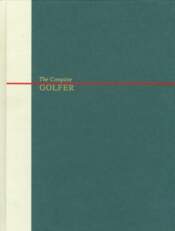 Edited by Herbert Warren Wind Odds are against you in most games of chance. But if you ever wanted a sure bet, give this book to any golfer as a gift. It is similar to lunch at Muirfield; many choices through many courses, all worthy of the finest table, and all shared convivially. As such, it is sure to satisfy every palate. Open The Complete Golfer anywhere and you are very likely to find something you enjoy. The reason is due largely to the wonderful choices made for this anthology by editor Herbert Warren Wind. A quality miscellany requires good selection by the compiler, a success often determined by their breadth of knowledge on the subject. Wind was in his best form in the early 1950s after writing The History of American Golf (a Classics of Golf title) and joining the staff of the New Yorker in 1949. He spent two years researching the literature of golf for his top picks in a variety of disciplines for this volume. Bobby Jones writes in the original introduction, “Golf has more than enough in it to command the respect of any man.” Considerable literature will develop around such a game continues Jones, “History, humor, curiosities, stories of championships, essays on methods…and every golfer, I think, owes it to himself to have an acquaintance with this literature.” To ease into this familiarity, Wind begins lightheartedly with fiction and a selection of cartoons. This seemingly innocent beginning is good preparation for the meatier third section The Spirit of the Game with history, comments, reminiscences and some humor. Francis Ouimet gives an intimate view of growing up across the street from the country club; how he would sneak on and play until discovered and chased by the greenkeeper. H. B. Martin tells us how golf came into American legitimacy with the 1888 formation of The Saint Andrew’s Golf Club in Yonkers, NY, and how the “Old Apple Tree Gang” received its name. Grantland Rice’s article for The American Golfer (see the Classics of Golf selection by the same title for many more articles) is one of the most insightful ever written on Bobby Jones’ preparation for his record-setting Grand Slam year. Rice prophetically closes The Prospect for 1930 with: “There is at least a first class chance that this will be the best year he has ever had, and that will mean the best year any individual golfer ever had.” If Jones is your cup of tea, you will read and reread Bernard Darwin’s The Immortal Bobby, one of the best pieces ever written on the man. Another famous Jones, Robert Trent Jones, contributed an excellent chapter of substance on golf course architecture entitled From St. Andrews to the Modern American Courses. He offers an overview of the history of his craft but focuses on several modern courses to explain current theory. The discussions are facilitated by the inclusion of a series of color course maps. Pinehurst No. 2, Pine Valley, Merion, Pebble Beach, Augusta National, The National Golf Links, and Oakland Hills are detailed and studied in comparison with The Old Course. One other course is omitted from that list, not to slight it because only one hole was used, but to single it out. It is uniquely significant in Jones’ view; it is the only other hole he discusses from all the remaining courses in Britain. “The Redan—the fifteenth hole at North Berwick—takes its name from the famous redoubt at Sevastopol, which the British stormed in 1855…the Redan holds a salient position in the development of golf architecture. It was one of the first holes to demonstrate the beauties of strategic design so forcibly that it was copied at many other courses, and it became a touchstone for golf course layout.” The section on Great Players, Historic Moments has enough stories for a dozen Hollywood movies. Walter Travis writes on how he won the Amateur Championship. Byron Nelson is profiled immediately after he broke the PGA record for consecutive tournament wins with six (Nelson was on his way to an insurmountable record of 11 victories in a row—he was that good.) One article exemplifies the type of attitude that is presently lost from the professional game: star player Gene Sarazen writes a heartfelt article about Walter Hagen– My Hero, My Rival exhibiting sportsmanship befitting a gentleman. In an autobiographical piece, Sarazen also relates how he played the last 28 holes of the 1932 U. S. Open in 100 strokes, over a tough Tillinghast layout. Even those who do not like, or do not think they need instruction will benefit from The Masters’ Voices. Wind does not select staid instructors who might begin with “Now place your hand on the club…” Wind offers Willie Park, Jr., on The Importance of Style; How Hogan Picks His Clubs by his pal Jimmy Demaret; and It Takes Brains to Play Golf by Gene Sarazen. The list of able contributors and engaging methods is, as in prior chapters, impressive and important. There are many fine excerpts, columns, stories and recollections not mentioned here for you to discover at your leisure. Whether enjoyed by article or chapter, The Complete Golfer offers as diverse and excellent a selection of golf literature as one might reasonably put between the covers of a book. Forewords by Herbert Warren Wind and Robert T. Jones, Jr., Afterword by Frank Hannigan
Edited by Herbert Warren Wind Odds are against you in most games of chance. But if you ever wanted a sure bet, give this book to any golfer as a gift. It is similar to lunch at Muirfield; many choices through many courses, all worthy of the finest table, and all shared convivially. As such, it is sure to satisfy every palate. Open The Complete Golfer anywhere and you are very likely to find something you enjoy. The reason is due largely to the wonderful choices made for this anthology by editor Herbert Warren Wind. A quality miscellany requires good selection by the compiler, a success often determined by their breadth of knowledge on the subject. Wind was in his best form in the early 1950s after writing The History of American Golf (a Classics of Golf title) and joining the staff of the New Yorker in 1949. He spent two years researching the literature of golf for his top picks in a variety of disciplines for this volume. Bobby Jones writes in the original introduction, “Golf has more than enough in it to command the respect of any man.” Considerable literature will develop around such a game continues Jones, “History, humor, curiosities, stories of championships, essays on methods…and every golfer, I think, owes it to himself to have an acquaintance with this literature.” To ease into this familiarity, Wind begins lightheartedly with fiction and a selection of cartoons. This seemingly innocent beginning is good preparation for the meatier third section The Spirit of the Game with history, comments, reminiscences and some humor. Francis Ouimet gives an intimate view of growing up across the street from the country club; how he would sneak on and play until discovered and chased by the greenkeeper. H. B. Martin tells us how golf came into American legitimacy with the 1888 formation of The Saint Andrew’s Golf Club in Yonkers, NY, and how the “Old Apple Tree Gang” received its name. Grantland Rice’s article for The American Golfer (see the Classics of Golf selection by the same title for many more articles) is one of the most insightful ever written on Bobby Jones’ preparation for his record-setting Grand Slam year. Rice prophetically closes The Prospect for 1930 with: “There is at least a first class chance that this will be the best year he has ever had, and that will mean the best year any individual golfer ever had.” If Jones is your cup of tea, you will read and reread Bernard Darwin’s The Immortal Bobby, one of the best pieces ever written on the man. Another famous Jones, Robert Trent Jones, contributed an excellent chapter of substance on golf course architecture entitled From St. Andrews to the Modern American Courses. He offers an overview of the history of his craft but focuses on several modern courses to explain current theory. The discussions are facilitated by the inclusion of a series of color course maps. Pinehurst No. 2, Pine Valley, Merion, Pebble Beach, Augusta National, The National Golf Links, and Oakland Hills are detailed and studied in comparison with The Old Course. One other course is omitted from that list, not to slight it because only one hole was used, but to single it out. It is uniquely significant in Jones’ view; it is the only other hole he discusses from all the remaining courses in Britain. “The Redan—the fifteenth hole at North Berwick—takes its name from the famous redoubt at Sevastopol, which the British stormed in 1855…the Redan holds a salient position in the development of golf architecture. It was one of the first holes to demonstrate the beauties of strategic design so forcibly that it was copied at many other courses, and it became a touchstone for golf course layout.” The section on Great Players, Historic Moments has enough stories for a dozen Hollywood movies. Walter Travis writes on how he won the Amateur Championship. Byron Nelson is profiled immediately after he broke the PGA record for consecutive tournament wins with six (Nelson was on his way to an insurmountable record of 11 victories in a row—he was that good.) One article exemplifies the type of attitude that is presently lost from the professional game: star player Gene Sarazen writes a heartfelt article about Walter Hagen– My Hero, My Rival exhibiting sportsmanship befitting a gentleman. In an autobiographical piece, Sarazen also relates how he played the last 28 holes of the 1932 U. S. Open in 100 strokes, over a tough Tillinghast layout. Even those who do not like, or do not think they need instruction will benefit from The Masters’ Voices. Wind does not select staid instructors who might begin with “Now place your hand on the club…” Wind offers Willie Park, Jr., on The Importance of Style; How Hogan Picks His Clubs by his pal Jimmy Demaret; and It Takes Brains to Play Golf by Gene Sarazen. The list of able contributors and engaging methods is, as in prior chapters, impressive and important. There are many fine excerpts, columns, stories and recollections not mentioned here for you to discover at your leisure. Whether enjoyed by article or chapter, The Complete Golfer offers as diverse and excellent a selection of golf literature as one might reasonably put between the covers of a book. Forewords by Herbert Warren Wind and Robert T. Jones, Jr., Afterword by Frank Hannigan -
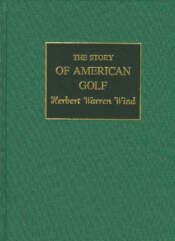 By Herbert Warren Wind Wind's masterpiece is one of the great books in golf. In the second half of the twentieth century, Wind contributed as much to golf as the force of nature with which he shares a name. He helped Ben Hogan codify his knowledge of the swing and Gene Sarazen and Jack Nicklaus tell their life stories in riveting fashion. (He also gave Amen Corner its name.) And, like a certain famous Englishman, he took golf reportage to a new level of specificity, insight and narrative grace, writing primarily for the New Yorker. He always saw himself as the heir and apprentice to Bernard Darwin, but in some ways he surpassed the master, translating his principles into a lively, colloquial American idiom. First published in 1948, Wind's most cohesive work traced American golf from its earliest stirrings in Yonkers, New York, in 1888. He updated the book in 1956 and again in 1975, nearly doubling its size. The Story of American Golf is just that—a great story. You can't put it down even though you know how it all turns out Afterword by Robert. S. Macdonald.
By Herbert Warren Wind Wind's masterpiece is one of the great books in golf. In the second half of the twentieth century, Wind contributed as much to golf as the force of nature with which he shares a name. He helped Ben Hogan codify his knowledge of the swing and Gene Sarazen and Jack Nicklaus tell their life stories in riveting fashion. (He also gave Amen Corner its name.) And, like a certain famous Englishman, he took golf reportage to a new level of specificity, insight and narrative grace, writing primarily for the New Yorker. He always saw himself as the heir and apprentice to Bernard Darwin, but in some ways he surpassed the master, translating his principles into a lively, colloquial American idiom. First published in 1948, Wind's most cohesive work traced American golf from its earliest stirrings in Yonkers, New York, in 1888. He updated the book in 1956 and again in 1975, nearly doubling its size. The Story of American Golf is just that—a great story. You can't put it down even though you know how it all turns out Afterword by Robert. S. Macdonald.

